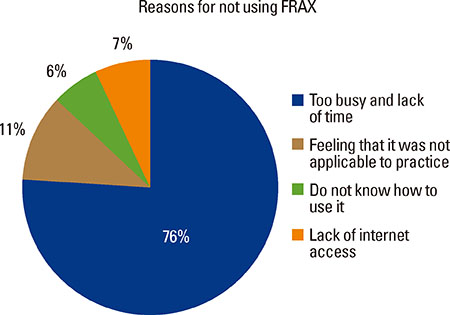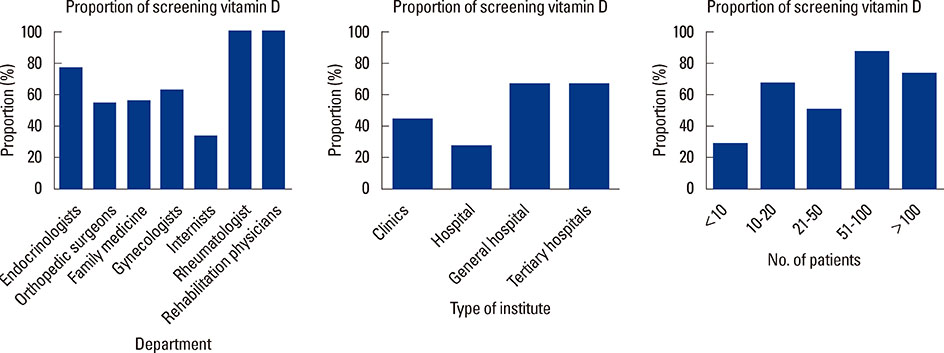Physicians' Attitudes to Contemporary Issues on Osteoporosis Management in Korea
- Affiliations
-
- 1Department of Orthopaedic Surgery, Chung-Ang University College of Medicine, Seoul, Korea.
- 2Department of Orthopaedic Surgery, Seoul National University Bundang Hospital, Seongnam, Korea. ykleemd@gmail.com
- 3Department of Obstetrics and Gynecology, Yeouido St. Mary's Hospital, The Catholic University of Korea, Seoul, Korea.
- 4College of Pharmacy, Gachon University, Incheon, Korea.
- 5Division of Endocrinology and Metabolism, Department of Internal Medicine, Seoul National University College of Medicine, Seoul, Korea.
- KMID: 2241535
- DOI: http://doi.org/10.11005/jbm.2014.21.2.143
Abstract
- BACKGROUND
In management of osteoporosis, several concerns here have been raised. The current issue included the utilization of dual energy X-ray absorptiometry (DXA) and fracture-risk assessment (FRAX), screening of vitamin D deficiency and secondary osteoporosis, and long-term use of bisphosphonate and calcium supplements. There was no study on physicians' attitude on these current issues in Korea. Therefore, we investigated the physicians' attitude on these issues by survey.
METHODS
We administered a 30-item questionnaire to all members of Korean Society for Bone and Mineral Research by email survey form. One hundred participants answered the questionnaire. The questionnaire included the questions about the physicians' attitude to current issues and the barriers to osteoporosis treatment in Korea.
RESULTS
Most physicians used bone densitometry devices (99%) and, central DXA was the most accessible device (95%). Eighty-eight percent were aware of FRAX(R), but among them, only 19.3% used it. The main reason for not using FRAX(R) was the lack of time in their proactive (76%). Screening for vitamin D status and secondary osteoporosis was performed by 59% and 52% of the respondents, respectively. The lack of awareness among patients and high costs of medication were perceived as the most important barriers to osteoporosis management in Korea.
CONCLUSIONS
This study provides physicians' perspective to the current issue for diagnostic and treatment of osteoporosis in Korea. To further improve osteoporosis management, educational programs for patients and doctors, and the improvement of reimbursement system should be considered in Korea.
Keyword
MeSH Terms
Figure
Cited by 6 articles
-
Hip and Subtrochanteric or Femoral Shaft Fractures after Bisphosphonate Use in Korean Women, Using Korean National Sample Cohort
Seok-Hyung Won, Soyeon Ahn, Eunjeong Ji, Jung Wee Park, Jin-Kak Kim, Young-Kyun Lee
J Korean Med Sci. 2020;35(25):e193. doi: 10.3346/jkms.2020.35.e193.Low Positive Predictive Value of Bone Scan to Predict Impending Complete Fracture among Incomplete Atypical Femoral Fracture
Young-Kyun Lee, You Jin Lee, Na Kyoung Lee, Jae-Hwi Nho, Kyung-Hoi Koo
J Korean Med Sci. 2018;33(22):. doi: 10.3346/jkms.2018.33.e157.Undertreatment of Osteoporosis Following Hip Fractures in Jeju Cohort Study
Sang-Rim Kim, Yong-Geun Park, Soo Yong Kang, Kwang Woo Nam, Yong-Gum Park, Yong-Chan Ha
J Bone Metab. 2014;21(4):263-268. doi: 10.11005/jbm.2014.21.4.263.Oral Bisphosphonate and Risk of Esophageal Cancer: A Nationwide Claim Study
Gi Hyeon Seo, Hyung Jin Choi
J Bone Metab. 2015;22(2):77-81. doi: 10.11005/jbm.2015.22.2.77.Can Alarming Improve Compliance with Weekly Bisphosphonate in Patients with Osteoporosis?
Jae-Hwi Nho, Young-Kyun Lee, Yong-Chan Ha, Chung-Hyun Kim, You-Sung Suh, Kyung-Hoi Koo
J Bone Metab. 2016;23(2):51-54. doi: 10.11005/jbm.2016.23.2.51.Incidence Rate of Atypical Femoral Fracture after Bisphosphonates Treatment in Korea
Young-Kyun Lee, Soyeon Ahn, Kyoung Min Kim, Chang Suk Suh, Kyung-Hoi Koo
J Korean Med Sci. 2018;33(5):. doi: 10.3346/jkms.2018.33.e38.
Reference
-
1. Reginster JY, Burlet N. Osteoporosis: a still increasing prevalence. Bone. 2006; 38:S4–S9.
Article2. Borgström F, Sobocki P, Ström O, et al. The societal burden of osteoporosis in Sweden. Bone. 2007; 40:1602–1609.
Article3. Salaffi F, Cimmino MA, Malavolta N, et al. The burden of prevalent fractures on health-related quality of life in postmenopausal women with osteoporosis: the IMOF study. J Rheumatol. 2007; 34:1551–1560.4. Yoon HK, Park C, Jang S, et al. Incidence and mortality following hip fracture in Korea. J Korean Med Sci. 2011; 26:1087–1092.
Article5. Lee YK, Jang S, Jang S, et al. Mortality after vertebral fracture in Korea: analysis of the National Claim Registry. Osteoporos Int. 2012; 23:1859–1865.6. Park C, Ha YC, Jang S, et al. The incidence and residual lifetime risk of osteoporosis-related fractures in Korea. J Bone Miner Metab. 2011; 29:744–751.
Article7. Johansson H, Kanis JA, Oden A, et al. BMD, clinical risk factors and their combination for hip fracture prevention. Osteoporos Int. 2009; 20:1675–1682.
Article8. Middleton RG, Shabani F, Uzoigwe CE, et al. FRAX and the assessment of the risk of developing a fragility fracture. J Bone Joint Surg Br. 2012; 94:1313–1320.
Article9. Lee YK, Ha YC, Park C, et al. Bisphosphonate use and increased incidence of subtrochanteric fracture in South Korea: results from the National Claim Registry. Osteoporos Int. 2013; 24:707–711.
Article10. Reid IR. Cardiovascular effects of calcium supplements. Nutrients. 2013; 5:2522–2529.
Article11. Bolland MJ, Grey A, Reid IR. Calcium supplements and cardiovascular risk in the Women's Health Initiative. Osteoporos Int. 2013; 24:2371–2372.
Article12. Korthoewer D, Chandran M. Osteoporosis management and the utilization of FRAX(R): a survey amongst health care professionals of the Asia-Pacific. Arch Osteoporos. 2012; 7:193–200.
Article13. Lee YK, Ha YC, Choi HJ, et al. Bisphosphonate use and subsequent hip fracture in South Korea. Osteoporos Int. 2013; 24:2887–2892.
Article14. Lewiecki EM, Baim S, Binkley N, et al. Report of the International Society for Clinical Densitometry 2007 Adult Position Development Conference and Official Positions. South Med J. 2008; 101:735–739.
Article15. Ohtera K, Ishii S, Matsuyama T. Influence of the vitamin D receptor alleles on human osteoblast-like cells. J Bone Joint Surg Br. 2001; 83:134–138.
Article16. Nuti R, Martini G, Valenti R, et al. Vitamin D status and bone turnover in women with acute hip fracture. Clin Orthop Relat Res. 2004; 208–213.
Article17. Sakuma M, Endo N, Oinuma T, et al. Vitamin D and intact PTH status in patients with hip fracture. Osteoporos Int. 2006; 17:1608–1614.
Article18. Hwang YC, Ahn HY, Jeong IK, et al. Optimal serum concentration of 25-hydroxyvitamin D for bone health in older Korean adults. Calcif Tissue Int. 2013; 92:68–74.
Article19. Lips P, Hosking D, Lippuner K, et al. The prevalence of vitamin D inadequacy amongst women with osteoporosis: an international epidemiological investigation. J Intern Med. 2006; 260:245–254.
Article20. National Osteoporosis Foundation. Physician's guide to prevention and treatment of osteoporosis. Washington, DC: National Osteoporosis Foundation;2003.21. Javid KS, Thien A, Hill R. Implementation of and compliance with NICE guidelines in the secondary prevention of osteoporotic fractures in postmenopausal women. Ann R Coll Surg Engl. 2008; 90:213–215.
Article22. American Association of Clinical Endocrinologists. AACE Clinical Practice Guidelines for the Prevention and Treatment of Postmenopausal Osteoporosis. J Fla Med Assoc. 1996; 83:552–566.23. Abrahamsen B, Eiken P, Eastell R. Subtrochanteric and diaphyseal femur fractures in patients treated with alendronate: a register-based national cohort study. J Bone Miner Res. 2009; 24:1095–1102.
Article24. Black DM, Kelly MP, Genant HK, et al. Bisphosphonates and fractures of the subtrochanteric or diaphyseal femur. N Engl J Med. 2010; 362:1761–1771.
Article25. Schilcher J, Michaelsson K, Aspenberg P. Bisphosphonate use and atypical fractures of the femoral shaft. N Engl J Med. 2011; 364:1728–1737.
Article26. Shane E, Burr D, Abrahamsen B, et al. Atypical subtrochanteric and diaphyseal femoral fractures: second report of a task force of the american society for bone and mineral research. J Bone Miner Res. 2014; 29:1–23.
Article27. McClung M, Harris ST, Miller PD, et al. Bisphosphonate therapy for osteoporosis: benefits, risks, and drug holiday. Am J Med. 2013; 126:13–20.
Article28. Compston J, Bowring C, Cooper A, et al. Diagnosis and management of osteoporosis in postmenopausal women and older men in the UK: National Osteoporosis Guideline Group (NOGG) update 2013. Maturitas. 2013; 75:392–396.
Article29. Boonen S, Vanderschueren D, Haentjens P, et al. Calcium and vitamin D in the prevention and treatment of osteoporosis - a clinical update. J Intern Med. 2006; 259:539–552.
Article30. Nowson CA. Prevention of fractures in older people with calcium and vitamin D. Nutrients. 2010; 2:975–984.
Article31. Simonelli C, Killeen K, Mehle S, et al. Barriers to osteoporosis identification and treatment among primary care physicians and orthopedic surgeons. Mayo Clin Proc. 2002; 77:334–338.
Article
- Full Text Links
- Actions
-
Cited
- CITED
-
- Close
- Share
- Similar articles
-
- Primary care physicians attitudes and practice for management of osteoporosis in Inchon city
- Attitudes toward Social Issues Related to Opioid Use among Palliative Care Physicians
- Contemporary Review of Idiopathic Sudden Sensorineural Hearing Loss: Management and Prognosis
- Physicians’ Attitudes on Management of Osteopenia in South Korea
- Attitudes of Physicians and Nurses toward with Disabled Person





